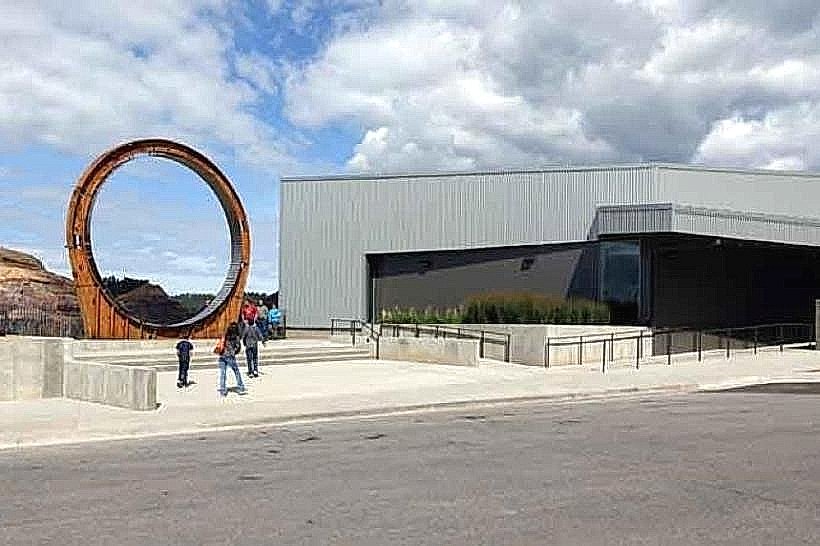Information
Landmark: Tatanka: Story of the BisonCity: Deadwood
Country: USA South Dakota
Continent: North America
Tatanka: Story of the Bison, Deadwood, USA South Dakota, North America
Overview
Perched on a ridge above Deadwood, Tatanka: Story of the Bison blends the feel of an open-air museum with the spirit of a cultural monument, honoring the deep bond between the Plains Indians and the American bison that once thundered across the prairie, besides after finishing *Dances with Wolves*, actor Kevin Costner envisioned the site, which opened in 2003 as a tribute to the buffalo-the creature that once guided the lives, trade, and spirit of Native peoples across the Great Plains, perhaps Just off Highway 85, only minutes from downtown Deadwood, this spot opens onto wide northern Black Hills vistas and rolling prairie beyond-a view so open and still you can almost picture how the land looked centuries ago, equally important at the center of the exhibit rises a dramatic bronze tableau-fourteen life-sized bison and three Native American riders on horseback, muscles taut and dust imagined in the air, caught forever in the fierce rush of a buffalo jump.Artist Peggy Detmers’ piece seems to pulse with movement-the animals’ muscles drawn tight, riders leaning forward with fierce concentration, in turn with prairie grass rippling in the wind, the scene turns into both art and story-a weathered echo of a time long gone.The open fields lie still and silent, brushed by the wind’s soft whistle through tall grass and the clear calls of meadowlarks, furthermore the smell of sage floats on the breeze, and far-off ridgelines melt softly into the pale edge of the sky.Truthfully, The area invites quiet reflection-it feels half memorial, half open-air classroom, with the faint rustle of leaves breaking the silence, in turn inside the visitor center, displays tell the story of the bison-its cultural, ecological, and spiritual meaning to the Lakota and other Plains tribes-while a faint scent of leather and earth lingers in the air.The exhibits trace traditional hunting practices, show how every part of the animal-from hide to bone-was used with care, and reveal the deep losses that followed the bison’s near-extinction in the 19th century, as well as authentic artifacts, lifelike dioramas, and flickering film reels weave a vivid story of survival, loss, and renewal.A brief documentary, introduced in vintage footage by Costner himself, gives background on how the site came to be and shares its message-a call to honor the bond between people and the natural world, like wind through tall grass, while many of the guides, rooted in Native heritage, share their stories and spoken traditions, adding a quiet authenticity and reverence you can almost feel in the air.Most visitors spend an hour or two exploring-strolling past bronze figures glinting in the sun before heading indoors to take in the exhibits, not only that along the ridge, benches invite you to pause and breathe in the view, where the hills roll out in layers of green and gold under drifting shadows, kind of Frankly, Along the path, modest bronze plaques tell how buffalo once thundered across these plains, leaping from cliffs and following age-aged migration routes, on top of that the gift shop and gallery highlight Native-made crafts, books, and artwork, keeping local culture alive-jewelry that catches the light, pages that smell faintly of cedar.Now and then, the center offers summer programs and talks where elders and historians share stories about how the bison shaped Native life-its spirit, its work, even the sound of hooves rolling across the plains.**Tatanka: Story of the Bison** reminds us that the bison isn’t just an animal-it’s a living emblem of resilience, identity, and a bond with the land, as steady and enduring as hoofprints pressed into dry prairie dust, moreover it recalls an age when the Great Plains throbbed with life-tens of millions of bison sweeping across the grass, and people moving in step with the quiet, steady beat of the land.The site isn’t just about nostalgia-it invites us to gaze closer at how people and nature stay in balance, like footprints fading into wet sand, after that visiting Tatanka feels almost meditative-like stepping into history and making a quiet pilgrimage as the wind moves through the tall grass.You know, In the changing light, the bronze figures almost stir, while the hills hold a silence thick with aged memories and the faint scent of dust, moreover in the Black Hills, almost nowhere weaves art, nature, and story together with such clear, heartfelt grace-like paint catching the gold light at dusk, generally From the ridge, as shadows slide across the wide plains, visitors can feel what Costner wanted to keep alive-the steadfast spirit of the bison and the people whose lives once moved with its heavy breath.
Author: Tourist Landmarks
Date: 2025-11-02








